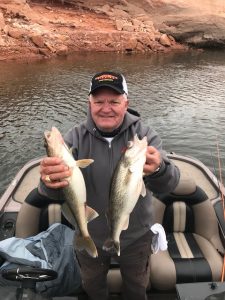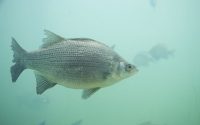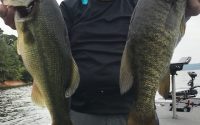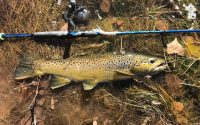It’s “March” at Lake Powell

A mild winter pushed forward conditions at Lake Powell and the fishery skipped February and moved right into March. This week’s column is dedicated to sharing the discoveries my good friend, Brent Daybell and I made while spending last Friday and Saturday on the water in the north end of the lake.
During “normal” winters, February is a time to locate stripers, walleyes, and crappies in the backs of deep, narrow canyons with “stair step” depths that abruptly rise from 100-plus feet to 80, 70, 50, and finally to around 30 feet of crystal clear water. Finding such canyons is always dependent on a good fish finder and a better understanding of the current elevation of the reservoir.
Then, in a canyon that meets the requirements, shad will pile up on one of several stair steps and the game fish will surround the schools, trapping them in the narrow channels or “managing” them by cutting off their escape routes. Then, a 1/2 –ounce white spoon dropped vertically to the suspended game fish results in a live well full of great-tasting fish.
Finding Canyons and Shad
However, after heading north from Bullfrog Marina, we arrived at two of our favorite canyons just shy of Good Hope Bay only to discover that no striper schools were anywhere around the stair steps heading toward the back of the canyons. In fact, we didn’t catch a single striper in the areas that “normally” hold both shad and stripers in abundance.
As we explored the canyon, and even moved farther in towards the back, schools of tightly grouped fish wormed their way across the screen of my fish finder as if in a frenzy. Thinking we had finally found our game fish, we dropped our spoons yet didn’t hook up a single time. Eventually we realized those groups of fish showing on the finder were actually adult gizzard shad moving into the shallow water of the backs of the canyons.
This shad behavior happens in March as they stage before the spawn. The water temperature hung at 49 degrees in the morning but by Noon, it spiked up to 50 and by 3:00 p.m., it topped off at 53 degrees. As a result, we switched gears, tied on tube jigs, crankbaits, and spinnerbaits, and began looking for large and smallmouth bass.
Success at Last.
After checking for stripers in yet another deep canyon, I threw a crawdad-colored jig to the deep end of a rock pile and a 3-pound largemouth inhaled the lure. Next, some smallmouth bass ate our tube jigs and our entire approach to the trip changed from targeting stripers to catching walleyes and bass.
As water temperatures creep up to and beyond 50 degrees, the entire lake changes. Gone are the winter blues, and all species in the lake “wake up” and get on with their lives of eating, resting, and getting ready to reproduce.
Though we only caught a half-dozen fish on Friday, we had confidence that if we were to imagine it was the first week in March rather than the second week of February we could still have a great time on the water.
On Saturday, we fished closer to the ramp at Bullfrog bay and almost like clockwork found stripers in the middle of the bay (where they would be in March). The schools were not chasing shad but were resting in large groups in 45 feet of water. They responded eagerly to white spoons dropped directly under our boat. And, walleyes and large and smallmouth bass became active and responded to jigs, tubes, and other reaction baits.
As long as winter stays at bay and water temperatures continue to climb, all gamefish in Lake Powell will behave as if February was a figment of their imagination. The walleyes will begin to spawn soon, the bass will move towards the shallows, and stripers will show up from time to time chasing shad in the backs of wide open bays. Oh, and did I mention we one of only five boats on the lake?










